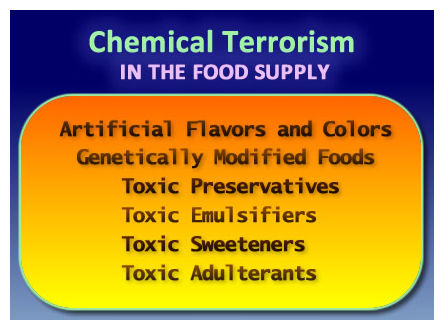Is it really that hard for most people to believe that we are being assaulted on a daily basis by chemical terrorism? Genetically modified foods, artificial flavours, colors, preservatives, emulsifiers, and sweeteners all made with toxic chemicals, all of which are proven toxic to human health. We are being bombarded on a daily basis by an astronomical level of toxicity, all controlled by these chemical terrorists on behalf of the food industry. Worse is we let them.

© Prevent Disease.com
How many more toxins will we permit in our food supply before we stand united and simply say "we've had enough?" How long will it take until we assertively proclaim that we will not allow any more chemicals or toxins in our foods?
Since food and health regulators cannot properly do their job to protect the public, there will come a tipping point when the people will have to do it for them. We discuss toxic chemicals almost every day, but what percentage of the population is interested enough, curious enough or most of all disciplined enough to actually make the dietary changes necessary to rid all the toxins from the foods they eat? How many people can avoid all processed foods every single day? I would estimate that percentage to be extremely small. Barriers are typically societal pressure, convenience and income. The reality is that we could all have a safe and healthy food industry if we truly wanted it. There are just not enough of us that want it that badly....yet.
Every year or two we have a new chemical terrorist making its way into the food supply almost like clock work. Once the public becomes savvy to the harmful nature of the new toxin, it is then renamed, rebranded and often modified into a deadlier form than its predecessor.
Aspartame and aminosweet, and
high fructose corn syrup and corn sugar are two excellent examples.
Let's take a look at some of the biggest offenders that are in more than 80% of the foods we eat.








